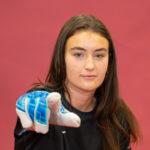SoccerWire Q&A: Joy of the People founder Ted Kroeten
WASHINGTON — The Urban Soccer Symposium brings together a diverse group of people from across the country with a wide variety of ideas on the best ways to coach young players in the game and help them develop.
 One of the more unique organizations represented at this year’s edition in downtown Washington, D.C. is Joy of the People (JOTP), a group based in St. Paul, Minn. who advocate for soccer as a way to help children lead healthier lives and become more interested and retain that interest in the sport.
One of the more unique organizations represented at this year’s edition in downtown Washington, D.C. is Joy of the People (JOTP), a group based in St. Paul, Minn. who advocate for soccer as a way to help children lead healthier lives and become more interested and retain that interest in the sport.
The name comes from the Portuguese phrase “Alegria do povo,” which means “Joy of the people” and is the Brazilian expression for soccer played at its best, with skill and joy.
JOTP emphasize the beautiful game’s value as a fun way to exercise for children, and they look to build spaces for soccer wherever available to promote unstructured free play. It is a conscious reaction to the hyper-competitive youth soccer scene across the country, where young children and their families often pay steep fees to play on travel soccer teams in weekend league play.
[ +Catch more Urban Soccer Symposium coverage here ]
The organization presented their ideas at the Urban Soccer Symposium at the end of the second day after a packed schedule of workshops and other events. SoccerWire.com caught up with founder and artistic director Ted Kroeten to get an insight into their particular brand of youth soccer.
SoccerWire: What are the big benefits of the free play model for you?
Ted Kroeten: The free play model is essential to generally healthy kids. It’s essential to building communities, it’s the original community-builder. I think it’s for kids who want to become as good as they can be. I think it’s absolutely necessary, otherwise you just don’t get that acquisition period of time in a play setting.
SW: So it’s about enjoyment?
TK: Correct. And many coaches, when they hear the word “enjoyment,” they immediately think it’s a second-class education program. In their academy model, that would be much better for them, and this would be a second or third idea. In absolute truth, if you look at best practises, there is no elite development without this low-level fun, recreational acquisition period.
SW: What kind of ages are you aimed at?
TK: I really don’t believe kids get into free play until they hit a socialization zone. Most 6-year-olds don’t have a best friend yet, they’re attached to their parents. Their free play should be with their parents. Something happens between the ages of 7 and 9 where the kid gets a best friend, is ready to step into that social environment. If we push them in too soon, they can get stirred and have a bad experience. If they’re ready and they step into the game and they like it, then they don’t want to stop playing.
“The education learned through hours on the street will always overwhelm the trained, drilled, athletic.” – Joy Of The People
SW: When it comes to the competitive nature of soccer in this country, do you feel that perhaps doesn’t help kids develop as much? Do they perhaps play competitive too early?
TK: I would say 16 is probably too early, but I’m out there. Diego Maradona wrote down the names of the kids he played with until he was 14, and there were 32 kids. Pelé played across his street until he was 15, and won three World Cups. We greatly overestimate the idea of travel leagues and we greatly underestimate the power of backyard, neighborhood play. It’s killed communities, it’s killed parks. It’s empowered the youth programs, these youth clubs and travel clubs. However, it’s not producing players.
SW: And the kids aren’t enjoying themselves?
TK: Correct. The coaches are enjoying it when they win state championships, and that’s the only person in the whole state that can truly say they love youth and travel soccer.
[One of the things that JOTP advertized was their building of a Puckelball pitch. Pioneered in Malmo, Sweden by artist Johan Strom, Puckelball is an undulated field on which the bounce is irregular, teaching players to adapt in what is described as a metaphor for life. JOTP are looking to bring a Puckelball field to St. Paul as part of a larger development]
SW: I’m curious about this picture of Puckelball, I’ve never seen anything like that before.
TK: We are building a facility that we would like to see as the world example of how to bring kids back into the park to play. It would have lots of different services: futsal, court soccer, sand soccer, turf fields for regular soccer but also for something called Puckelball. It’s small-sided, 25×70 feet. It’s a really holey undulated field that’s meant to be a playground for soccer.
 A lot of times when mini fields are built, they’re taken over quickly by organized leagues and there’s still no place for kids to play. This undulated field might set an example. As parents set their kids free to go and play on the swings and the monkey bars, maybe this will give them the idea to send a 5, 6, 7-year old to go and play soccer. It looks like fun, it says ‘play.’
A lot of times when mini fields are built, they’re taken over quickly by organized leagues and there’s still no place for kids to play. This undulated field might set an example. As parents set their kids free to go and play on the swings and the monkey bars, maybe this will give them the idea to send a 5, 6, 7-year old to go and play soccer. It looks like fun, it says ‘play.’
The artist in Sweden, Johan Strom, believes that soccer, like life, is not fair and should never be considered fair, and we should never expect the ball to bounce the same way twice. The goal should be the correct size, but everything is different.
SW: It’s about kids being in something very different and coping and adapting?
TK: It goes on a theory that learning is more adaptation than it is about reaching perfection. It’s more about the ability to continually adapt. You think about the human species and our nature of our evolution, that’s really what we’re about. We do not seek perfection, but instead adapt, adapt, adapt. It is a way of seeking perfection, but perfection can never be captured. It’s our goal as humans, I think, to seek perfection through adaptation.











